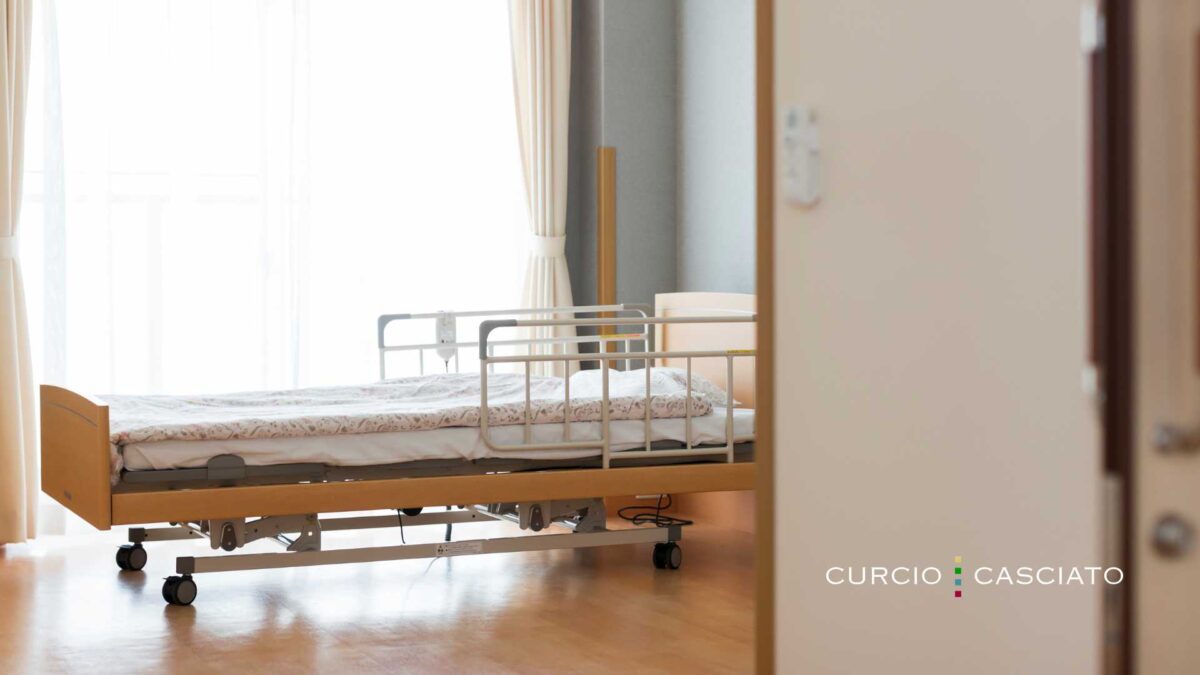Understanding the difference between a Kennedy ulcer vs bed sore is necessary when evaluating the care your loved one is receiving in an Illinois nursing home. At Curcio & Casciato, we understand how overwhelming it can be for family members to see skin conditions, especially in situations where you believe your family member may be suffering from bed sores or pressure ulcers from neglect.
Sometimes, nursing homes will tell a resident’s family members that the resident is suffering from Kennedy terminal ulcers instead of pressure ulcers or bedsores to reduce the risk of liability in a medical malpractice lawsuit.
If you believe your loved one is suffering from or died because of pressure sore or other pressure injuries caused by improper wound care and lack of appropriate care within a nursing facility, our Chicago nursing home bedsore lawyers can help. We understand the differences between an end-of-life Kennedy ulcer and a pressure ulcer caused by extended pressure and failure to take preventive measures.
Our medical malpractice lawyers in Chicago have the experience and knowledge to investigate the circumstances, identify signs of negligence, and help you take legal action to protect your loved one’s rights.
If you need help holding a negligent nursing home accountable, let us lend a hand. Call (312) 321-1111 or contact us online to schedule a free consultation and speak with an experienced attorney today.
What is a Kennedy Ulcer?
A Kennedy ulcer, or Kennedy terminal ulcer, is a type of pressure ulcer that typically develops quickly and is often associated with the end-of-life process. Kennedy terminal ulcers are characterized by their sudden onset and occur as a result of skin failure caused by terminal systemic factors
They are believed to occur due to a combination of factors, including limited blood flow, tissue death, and the body’s overall decline during the final stages of life.
A Kennedy ulcer typically presents as an irregularly shaped skin wound with a discoloration ranging from red to purple, often progressing rapidly to black. These ulcers are often referred to as “skin failure,” meaning Kennedy terminal ulcers result from the body’s largest organ, the skin, shutting down rather than external factors like the shear forces of the patient’s total body weight on bony prominences. They are most common in terminally ill or severely compromised patients, signifying an impending death.
While Kennedy ulcers are not necessarily a sign of neglect, misidentifying or neglecting to address them can raise concerns in nursing care facilities, particularly if palliative nursing care plans are not in place.

What Does a Kennedy Ulcer Look Like?
A Kennedy ulcer, also known as a Kennedy terminal ulcer, is a specific type of deep tissue injury that stands out from other pressure ulcers due to its rapid onset and unique characteristics. Unlike standard bed sores, which typically develop over time from localized pressure, friction, and the shear forces of a patient’s total body weight, a Kennedy ulcer appears suddenly and progresses quickly, often within hours. These Kennedy terminal ulcers are most commonly found near bony prominences, such as the sacrum, and are associated with systemic effects often seen in critically ill individuals nearing the end of life.
Kennedy ulcers are irregularly shaped, often resembling a butterfly, pear, or horseshoe. The skin discoloration around the ulcer is distinct, with shades ranging from red to deep purple, maroon, or black, sometimes giving the area a mottled appearance. While they can initially appear as areas of intact skin, Kennedy terminal ulcers rapidly deepen, showing significant tissue damage in a short period.
Unlike other pressure injuries caused primarily by mechanical pressure, Kennedy ulcers are linked to systemic effects, such as limited blood flow and dropping blood pressure, which affect the body’s ability to deliver oxygen and nutrients to the skin and tissues. This combination of systemic effects makes Kennedy ulcers a sign of the body’s overall decline, often occurring in individuals experiencing multi-organ failure or terminal conditions, signifying tissue death, failure of other organ systems, and impending death. Their quick progression and lack of response or wound healing to typical wound care further differentiate them from other bed sores.
What Causes Kennedy Ulcers?
Kennedy ulcers are caused by terminal systemic factors such as limited blood flow, reduced oxygen delivery to other organ systems, and the body’s declining ability to heal. Prolonged pressure, shear forces, and the total body weight pressing on specific areas contribute to tissue death, especially in patients with terminal illnesses. The combination of these factors, along with the natural shutdown of other organ systems, leads to the rapid progression of these ulcers.
Signs of a Kennedy Terminal Ulcer
- Sudden onset: A Kennedy terminal ulcer develops quickly, often within hours, making it different from typical pressure ulcers.
- Irregular shape and dark color: A Kennedy ulcer is a specific type of skin wound that is irregularly shaped and may appear dark red, purple, blue, or black.
- Located over bony prominences: Kennedy ulcers usually form in areas under prolonged pressure, such as the sacral region (lower back or tailbone).
- Rapid progression: Unlike a typical pressure injury, Kennedy terminal ulcers worsen very rapidly due to skin failure in the final stages of life.
- Unresponsive to treatment: Because patients identified as having a terminal illness are nearing the end of life, wound healing is often not possible, and care focuses on pain management instead of recovery.
Kennedy Terminal Ulcer vs Pressure Ulcer Stages
The difference between Kennedy ulcers and pressure ulcers lies in their causes and progression. Pressure ulcers form over time due to extended pressure on the skin, often from neglect by healthcare professionals or the complications of immobility.
The medical community uses the pressure ulcer staging system to categorize the skin wound based on severity, from mild redness to deep tissue injury.
On the other hand, a Kennedy terminal ulcer can develop within hours as part of a person’s terminal status, signaling the body’s inability to heal in end-of-life states. Since the skin is the body’s largest organ, skin failure is a reflection of the decline happening throughout the entire body. Unlike pressure sore injuries, Kennedy terminal ulcers are not usually preventable and often require further evaluation to provide comfort-focused care instead of wound care.
How Long Does a Person Live After Developing a Kennedy Ulcer?
Kennedy ulcers are often mistaken for stage 4 bedsores because both bedsores involve severe tissue damage and can appear in similar areas, such as the sacral region. However, the causes and progression of pressure and Kennedy terminal ulcers are very different.
A stage 4 pressure ulcer most often develops due to prolonged pressure and medical malpractice from healthcare professionals in nursing care facilities. The stage 4 bedsore life expectancy in Chicago nursing homes can vary depending on how quickly proper wound care is provided. In contrast, a Kennedy ulcer signals the body’s impending death during the end-of-life state and is not usually caused by neglect or medical malpractice. Kennedy terminal ulcers appear suddenly and can progress within hours, reflecting the body’s inability to heal.
Because of their similar appearance, further evaluation is necessary to determine whether the resident is suffering from a bedsore or Kennedy ulcer.

Kennedy Ulcer vs Pressure Ulcer
Kennedy ulcers and pressure ulcers can look similar, but they have distinct causes and wound care requirements.
Pressure Ulcers
Pressure ulcers, often called bed sores, happen when prolonged pressure reduces blood flow to the skin, causing tissue damage. In severe cases, like a stage 4 bedsore in Chicago or unstageable pressure sore in Chicago the wound can extend to muscle or bone and may become life-threatening if not treated immediately.
These injuries are often linked to care neglect in a hospital or nursing home setting, especially for individuals with limited mobility. With timely intervention and wound care, however, many pressure ulcers can be prevented or managed before the skin fails completely.
Kennedy Terminal Ulcers
A Kennedy ulcer is different because it occurs as part of the natural dying process in individuals with a terminal illness or a serious medical diagnosis. Kennedy terminal ulcers appear suddenly and progress within hours as the skin fails due to the body shutting down during the end-of-life process.
Unlike pressure sores, Kennedy ulcers cannot be prevented or cured. They indicate the body’s inability to heal in the final stages of life. Wound care for these ulcers focuses on pain management rather than wound healing.
Preventative Measures for Kennedy Ulcer vs Bed Sores
While Kennedy ulcers are often unavoidable and a natural part of the dying process, most bed sores are preventable with proper care.
Palliative Care for Kennedy Ulcers
Palliative care for Kennedy ulcers focuses on providing comfort and managing symptoms. Since Kennedy terminal ulcers naturally occur during the dying process and cannot heal, the goal is to reduce pain and maintain as much skin integrity as possible.
Palliative nursing teams often use pressure-relieving dressings and charcoal-infused dressings to manage the wound and control any odor from wound exudate. A gentle turning schedule may still be followed to relieve pressure and keep the patient comfortable.
Are Pressure Ulcers Preventable?
Yes, most pressure ulcers can be prevented with proper care and attention. Healthcare professionals should regularly check residents for signs of pressure ulcers, reposition them frequently, and use support surfaces like specialized mattresses and cushions.
If pressure ulcers occur because healthcare providers fail to take preventive measures, they can be held accountable for failing to provide adequate care and protect residents’ well-being.

Can You File a Medical Malpractice Lawsuit for Kennedy Ulcers in Chicago?
Filing a medical malpractice lawsuit for Kennedy ulcers in Chicago depends on the circumstances surrounding the development of the Kennedy terminal ulcers.
Kennedy ulcers are associated with the dying process and are often unavoidable due to the body shutting down its final stages. However, if nursing home staff failed to provide necessary palliative care or misdiagnosed the Kennedy ulcer as another medical condition—it may constitute negligence.
The key here is that many facilities will claim a stage 4 bedsore was a Kennedy ulcer upon a resident’s death. This is because a family member can sue the facility for medical malpractice for preventable bedsores but typically cannot for Kennedy ulcers.
Nursing Home Misdiagnosis of Kennedy Terminal Ulcer
In some Chicago nursing facilities, families are often told that their loved one died of natural causes. Unfortunately, there are cases where preventable bedsores are misrepresented as Kennedy terminal ulcers to shift blame away from the facility. While Kennedy ulcers are a recognized part of the end-of-life process, true Kennedy ulcers develop rapidly and are linked to systemic failure in patients with a terminal illness. Bedsores, however, are preventable with proper care.
The difference lies in how these wounds develop and the role of wound care. Bedsores can often be avoided through routine repositioning, adequate hydration, and skin monitoring. When medical staff fails to provide this medical standard of care in Illinois, bedsores can quickly escalate, leading to severe infections or death if not treated immediately.
Kennedy ulcers are associated with the dying process. Mislabeling bedsores as Kennedy terminal ulcers can obscure the underlying types of negligence in Illinois by the nursing home.
The medical community recognizes that bedsores are preventable with wound care, making their presence red flags for neglect. When nursing homes fail to distinguish between Kennedy ulcers and pressure sores—or intentionally misrepresent them—it deprives families of the truth and accountability.
Families should not hesitate to question the care their loved one received and investigate whether medical negligence played a role in their passing.
How to Know if a Nursing Home Resident Has a Kennedy Ulcer or Bed Sore?
Determining whether a nursing home resident has a Kennedy ulcer or a bed sore can be challenging. A Kennedy ulcer occurs at the end of life, while a bed sore often results from neglect and can be prevented with appropriate care.
Clinical wound specialists and medical expert witnesses in Chicago can provide valuable insights into whether your loved one had a Kennedy ulcer or bedsore injury. In legal cases, clinical wound specialists and other medical experts can analyze medical records, evaluate care standards, and explain how the nursing home’s actions may have contributed to the injury.
How Our Chicago Nursing Home Abuse Lawyers Can Help
If your loved one has suffered from a pressure ulcer or a Kennedy terminal ulcer in a nursing home, it’s natural to feel concerned about their care. A skilled nursing home abuse attorney in Chicago from Curcio & Casiciato can help.
We understand how devastating it can be for a family member to see signs of neglect or improper care, and we work tirelessly to hold negligent nursing homes accountable. Whether the injury was preventable or mismanaged, we can investigate the circumstances, gather evidence, and fight for the justice your loved one deserves.

How Our Chicago Nursing Home Wrongful Death Attorneys Can Help
Losing a loved one due to nursing home neglect is a devastating experience, and the Chicago nursing home wrongful death lawyer team at Curcio & Casciato is here to provide the legal support you deserve. We are committed to holding negligent facilities accountable throughout Illinois. Our attorneys will thoroughly investigate the circumstances, gather evidence, and work tirelessly to seek justice for your family.
Call (312) 321-1111 for a free case evaluation.



